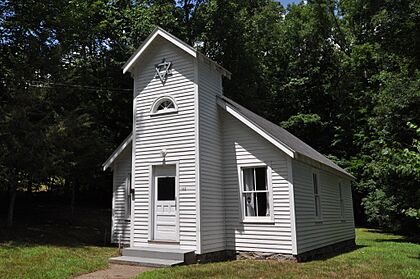Anshei Israel Synagogue facts for kids
Quick facts for kids Anshei Israel Synagogue |
|
|---|---|

The former Anshei Israel Synagogue
|
|
| Religion | |
| Affiliation | Orthodox Judaism (former) |
| Ecclesiastical or organisational status | Synagogue (1936–c. 1980s) |
| Ownership | Town of Lisbon |
| Status | Closed (as a synagogue) |
| Location | |
| Location | 142 Newent Road, (CT 138), Lisbon, Connecticut |
| Country | United States |
| Architecture | |
| Architectural type | Synagogue |
| Architectural style | Colonial Revival |
| General contractor | George Allen & Sons |
| Date established | unknown (as a congregation) |
| Completed | 1936 |
| Specifications | |
| Interior area | 20 by 30 feet (6.1 by 9.1 m) |
| Height (max) | 9 feet (2.7 m) |
| Materials | Clapboard |
The Anshei Israel Synagogue is an old Jewish synagogue building in Lisbon, Connecticut. It is located at 142 Newent Road. This building is important because it was added to the National Register of Historic Places in 1995. It was part of a group of 15 historic synagogues in Connecticut recognized for their importance.
A group of 15 families who followed Orthodox Judaism built this synagogue in 1936. A company called George Allen & Sons constructed it. Inside, there was one main room with benches and a special cabinet for holy scrolls. Over time, fewer people attended services. The synagogue eventually closed in the early 1980s. The town of Lisbon now owns the building. The Lisbon Historical Society helps take care of it.
Contents
Building the Synagogue
Around 1936, a man named Harry Rothenberg gave the land for the synagogue. The people in the community gathered their money to pay for the building. George Allen & Sons built the structure in 1936.
The Anshei Israel Synagogue is a building that is about 6 meters (20 feet) wide and 9 meters (30 feet) long. It has a pointed roof and is covered with wooden boards called clapboard. A tower sticks out from the front of the building. This tower is about 1.5 meters (5 feet) wide and 2.7 meters (9 feet) tall. At the very top of the tower, there is a Magen David, which is a six-pointed star that is a symbol of Judaism. On each side of the tower, there are two windows. Old paint shows that the window frames used to be a bright blue color.
Inside the Synagogue
The inside of the synagogue is one large room. At the front, there is a raised platform called a bimah. This is where the Torah (holy scrolls) would be read. Next to the bimah is the Torah ark, which is a special cabinet where the Torah scrolls are kept. Both the bimah and the ark are original parts of the building.
A gold curtain, called a parochet, covers the inside of the ark. A menorah, which is a special candleholder, sits on a stand nearby. There are chairs and five wooden benches for people to sit on. This seating arrangement was a bit unusual for old synagogues in Connecticut. The building had electricity, but it did not have heating or indoor plumbing. People used a wood stove to keep warm. There was an outhouse (an outdoor toilet) behind the synagogue.
How the Synagogue Was Used
The 15 families who started the synagogue came from countries like Poland and Russia. They lived in nearby towns such as Plainfield, Lisbon, Griswold, and Jewett City. Harry Rothenberg, who donated the land, became the first cantor (a person who leads prayers and sings) for the synagogue. It served the Orthodox Jewish community for many years.
During the 1940s and 1950s, fewer and fewer people were members of the congregation. This meant that services were only held on holidays. The synagogue finally closed in 1987. By then, there were not enough men (at least ten, called a minyan) to hold regular services. The town of Lisbon took over the property in the 1980s from the last six members of the synagogue. In 2004, the building was opened to the public during special "Walking Weekend" events.
Unique Practices
The synagogue building is still in good condition, but it is not used for services anymore. An article in a local newspaper, the New London Day, mentioned that some rules were not as strict here as they were in the "Old World" (meaning the countries where the families came from). For example, members of an Orthodox congregation were usually expected to walk to the synagogue. However, some members of Anshei Israel Synagogue who lived far away would drive most of the way and then walk the last mile or so.
Also, this synagogue did not use curtains to separate men and women during services. This was a common practice in Orthodox synagogues in Poland and Russia. Instead, the women sat at a table on the right side of the main room, near the door.
Why the Synagogue Is Important
The Anshei Israel Synagogue was one of 15 synagogues in Connecticut added to the National Register of Historic Places in 1995. It is important because it is a great example of a "small country Jewish house of worship." Its design is very simple. It is a significant Jewish place of worship built before 1945 that is located in a rural area. It still looks very much like it did when it was first built. The New London Day newspaper even suggested that this synagogue might be the "only one of its kind in the country." In 2001, the building was shown on Connecticut Journal, a TV show from Connecticut Public Television.
In 2005, the building needed some repairs because it had been neglected and squirrels had caused some damage. The Lisbon Historical Society received a grant of $5,000 to help pay for these repairs. Students from the Norwich Regional Vocational Technical School even replaced the electrical wiring for free.
See also


